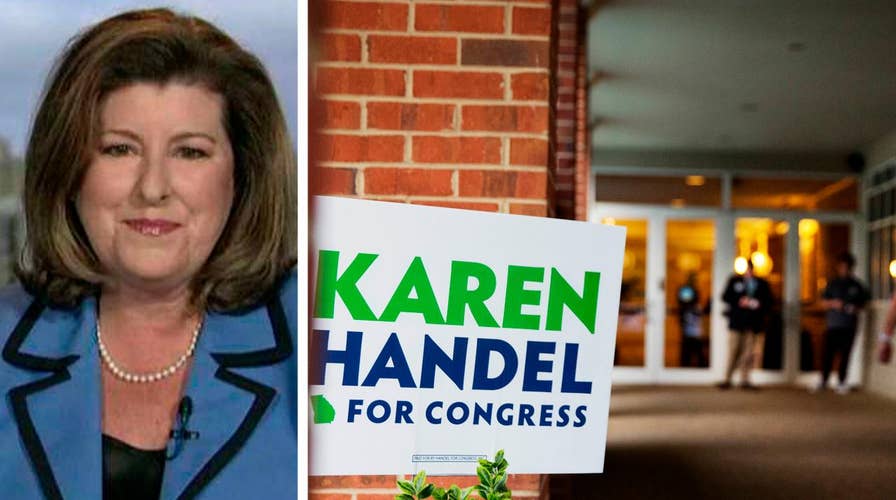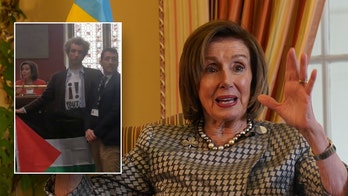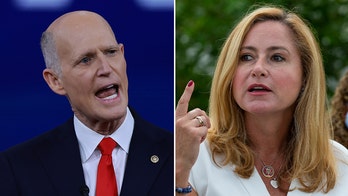Republican Karen Handel on Georgia race: I will prevail
On 'Fox & Friends,' congressional candidate looks ahead to runoff against Democrat Jon Ossoff
Old-timers used to leaf through the Farmer’s Almanac to learn of prognostications for a blizzard churning around Valentine’s Day or to determine whether drenching rains would douse their fields come early May.
The Almanac’s soothsaying is said to rely on mathematical equations, tidal movements and the prevalence of sunspots.
Special elections are kind of like the political version of the almanac. Sometimes they unveil a lot about the upcoming political weather. Sometimes, not so much.
The former is why much of political Washington poured over the results in two House special elections of late. Pundits filleted and quartered every precinct and trend. These votes were the first barometer of the electorate since President Trump scored his stunning victory last autumn. It’s notable that these two Republican districts were even remotely in play.
CIA Director Mike Pompeo vacated his southern Kansas district when the Senate confirmed him as the nation’s top spook.
The district favors Republicans by 15 percentage points and Trump outpolled Hillary Clinton by 27 points there last fall. But the GOP suffers “brand” issues in Kansas. Fox was told in the days ahead of the race that it was “way closer than it should be.”
Coupled with the rocky fiscal policies of Kansas GOP Gov. Sam Brownback, the nation’s least-popular governor, the district was ripe for an upset.
Still, Kansas Treasurer Ron Estes defeated Democrat James Thompson by 7 percentage points.
Thompson tried to convert the election into a referendum on the president, but fell short. Trump placed last-minute robo-calls to voters. The Democratic Congressional Campaign Committee, the national organization devoted to sending Democrats to the House, didn’t play in the race.
Republicans viewed the victory as validation of Estes, and (with no offense to the congressman-elect), more importantly, Trump.
Democrats contended that even a good showing in the district underscored their argument that the GOP is wounded and the President is toxic.
Maybe. Maybe not.
Then there was the special election in Georgia for the seat formerly occupied by Health and Human Services Secretary Tom Price.
Price cruised to victory in the district last fall by 24 points before his resignation. But the president narrowly carried the district. The suburban, educated district in the Atlanta suburbs (and Georgia generally) has seen some Democratic trends in recent years.
Democrat Jon Ossoff secured a plurality of the vote, scoring just under 50 percent. But he needed an absolute majority to avoid a June 20 runoff. Republican Karen Handel finished second.
Again, two ways to read this.
Are Democrats making inroads on red turf? Or, did they blow their chance to win the seat outright and send Ossoff to Congress now in what observers would surely interpret as the first repudiation of the president? After all, Republicans captured most of the vote in the district, slightly outpolling Ossoff. It could be hard for Ossoff to prevail in a one-on-one contest against Handel.
Then again, should it even be this close?
There’s a theory that a perceived weakness predicts a GOP fragility across the board and could put the House in play next fall. That’s still a tall order as Democrats need to capture 24 seats to reclaim the House for the first time since January, 2011.
And don’t forget about Montana. Interior Secretary Ryan Zinke resigned from Congress as the state’s at-large congressman. Montana sports a Democratic senator, and it wasn’t that long ago when Big Sky country featured two Democratic senators.
Missoula is the state’s second-largest city. A university town, Missoula features some left-wing leanings that offset the conservatism of Billings to the east. Democrat Rob Quist (a guitar-strumming cowboy) will face millionaire Republican Greg Gianforte on May 25 to succeed Zinke. A senior Republican source tells Fox, “We could lose Montana in a special election.”
Again, winning in Montana is a stretch for Democrats. But a win in Montana for Democrats would be big.
Unless it was just special circumstances driven by a special election. Small turnout. Bad weather. You name it.
In recent years, both parties focused on a number of House special elections and tried to portray them as electoral bellwethers.
In May 2008, Democrats capitalized on the public’s souring on the Republican Party and sent Rep. Don Cazayoux, D-La., to Congress in a special election over GOPer Woody Jenkins.
Democrats said the outcome accentuated energy on their side and rebuked President George W. Bush. And they predicted 2008 would be a Democratic year. After all, Democrats hadn’t held that deeply red district since 1974.
Democrats were right. President Obama captured the White House, racking up 365 electoral votes. And the party piled on to their already substantial House majority, picking up an additional 21 seats.
But how about Don Cazayoux? Come fall, then Congressman and now Sen. Bill Cassidy, R-La., defeated Cazayoux, thanks in part to a third party candidate. That flipped the seat back to Republican control after a brief dalliance with Democratic representation.
November 2009 featured a bizarre, almost incomprehensible race in upstate New York to succeed former GOP Rep. John McHugh. Obama tapped McHugh to serve as Army secretary.
Former Rep. Bill Owens, D-N.Y., prevailed over conservative Doug Hoffman. Republican Dede Scozzafava dropped out of the race because she wasn’t conservative enough. Former Alaska Gov. Sarah Palin, a Republican, played in the race, supporting Hoffman.
The campaign was the first major special election since Obama took office. Republicans argued that a GOP victory would prove the president and Democrats were on the ropes.
But Owens won, turning the district blue for the first time since 1873.
One would think the contest might demonstrate Democrats were faring well. As it turns out, the race meant little. Republicans handed Democrats their heads in the 2010 midterm elections, winning an astonishing 63 seats. Owens won a full term in November, 2010.
The next political weather vane arrived in the spring of 2010.
Rep. John Murtha, D-Pa., died that February. His longtime district director and later Rep. Mark Critz, D-Pa., ran in a May special election against Republican Tim Burns.
Democrats had just approved ObamaCare that March. Republicans and the Tea Party movement were howling. The GOP predicted the race could serve as a signpost of things to come that fall. There were assertions that Republicans needed to win that seat to have a shot at flipping control of the House.
It didn’t work out that way. Critz vanquished Burns handily in the special election.
So much for litmus tests. Critz even hung on in the general election in the fall of 2010 -- as Republicans rolled.
Rep. Keith Rothfus, R-Pa., defeated Critz in 2012.
Political observers cast their gaze on western New York in May 2011 after the abrupt resignation of then-Rep. Chris Lee, a Republican.
Lee sent a woman shirtless photos of himself, posing and flexing his muscles. Democrat and now-New York Lt. Gov. Kathy Hochul edged out GOPer Jane Corwin to claim the seat.
The district is one of the most rural and conservative in the state. No Democrat had represented that district in Washington in four decades. Corwin struggled after backing a plan by then-House Budget Committee Chairman Paul Ryan, R-Wis., to slash Medicare.
Democrats believed Hochul’s victory augured well for their effort to reclaim the House that fall. Democratic House candidates outpolled Republicans by 1.4 million votes nationally. Democrats cleaved the GOP advantage in the House that fall nearly in half. But the GOP retained control. Rep. Chris Collins, R-N.Y., toppled Hochul 51 percent to 49 percent.
So what did these special elections reveal? Should they serve as the political version of the Farmer’s Almanac? They are simply snapshots in time at a given place -- all complicated with individual local and national factors.
Frogs sometimes croak louder when a storm brews. Look for a dark, amber band on a woolly worm in the summer. That could mean a bad winter is in store. And we all know about the groundhog’s soothsaying in early February.
Special elections sometimes provide great clairvoyance as to what political trends are afoot. And often, they don’t.





